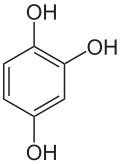Chemistry:Hydroxyquinol

| |
| Names | |
|---|---|
| Preferred IUPAC name
Benzene-1,2,4-triol | |
| Other names
Hydroxyhydroquinone
1,2,4-Benzenetriol 1,2,4-Trihydroxybenzene Benzene-1,2,4-triol 4-Hydroxycatechol 2,4-Dihydroxyphenol 1,3,4-Benzenetriol 1,3,4-Trihydroxybenzene | |
| Identifiers | |
| |
3D model (JSmol)
|
|
| ChEBI | |
| ChemSpider | |
| KEGG | |
PubChem CID
|
|
| UNII | |
| |
| |
| Properties | |
| C6H6O3 | |
| Molar mass | 126.11 g/mol |
| Appearance | white solid |
Except where otherwise noted, data are given for materials in their standard state (at 25 °C [77 °F], 100 kPa). | |
| Infobox references | |
Hydroxyquinol is an organic compound with the formula C6H3(OH)3. It is one of three isomeric benzenetriols. The compound is a colorless solid that is soluble in water. It reacts with air to give a black insoluble solid.[1]
Production
It is prepared industrially by acetylation of paraquinone with acetic anhydride followed by hydrolysis of the triacetate.[1]
Historically, hydroxyquinol was produced by the action of potassium hydroxide on hydroquinone.[2] It can also be prepared by dehydrating fructose.[3][4]
- C6H12O6 → 3 H2O + C6H6O3
Natural occurrence
Hydroxyquinol is a common intermediate in the biodegradation of many aromatic compounds. These substrates include monochlorophenols, dichlorophenols, and more complex species such as the pesticide 2,4,5-T.[5] Hydroxyquinol commonly occurs in nature as a biodegradation product of catechin, a natural phenol found in plants (e.g. by soil bacteria Bradyrhizobium japonicum).[6] Hydroxyquinol is also a metabolite in some organisms. For instance, Hydroxyquinol 1,2-dioxygenase is an enzyme that uses hydroxyquinol as a substrate with oxygen to produce 3-hydroxy-cis,cis-muconate.
References
- ↑ 1.0 1.1 Fiege, Helmut; Heinz-Werner, Voges; Hamamoto, Toshikazu; Umemura, Sumio; Iwata, Tadao; Miki, Hisaya; Fujita, Yasuhiro; Buysch, Hans-Josef et al. (2005). "Phenol Derivatives". Ullmann's Encyclopedia of Industrial Chemistry (Weinheim, Germany: Wiley-VCH). doi:10.1002/14356007.a19_313. ISBN 978-3527306732.
- ↑ Roscoe, Henry (1891). A treatise on chemistry, Volume 3, Part 3. London: Macmillan & Co.. pp. 199. https://books.google.com/books?id=HEY9AAAAYAAJ&q=hydroxyquinol&pg=PA199.
- ↑ Luijkx, Gerard; Rantwijk, Fred; Bekkum, Herman (1993). "Hydrothermal formation of 1,2,4-benzenetriol from 5-hydroxymethyl-2-furaldehyde and D-fructose". Carbohydrate Research 242 (1): 131–139. doi:10.1016/0008-6215(93)80027-C.
- ↑ Srokol, Zbigniew; Anne-Gaëlle, Bouche; Estrik, Anton; Strik, Rob; Maschmeyer, Thomas; Peters, Joop (2004). "Hydrothermal upgrading of biomass to biofuel; studies on some monosaccharide model compounds". Carbohydrate Research 339 (10): 1717–1726. doi:10.1016/j.carres.2004.04.018. PMID 15220081.
- ↑ Travkin, Vasili M.; Solyanikova, Inna P.; Golovleva, Ludmila A. (2006). "Hydroxyquinol pathway for microbial degradation of halogenated aromatic compounds". Journal of Environmental Science and Health, Part B 41 (8): 1361–1382. doi:10.1080/03601230600964159. PMID 17090498.
- ↑ Mahadevan, A.; Waheeta, Hopper (1997). "Degradation of catechin by Bradyrhizobium japonicum". Biodegradation 8 (3): 159–165. doi:10.1023/A:1008254812074.
 |

